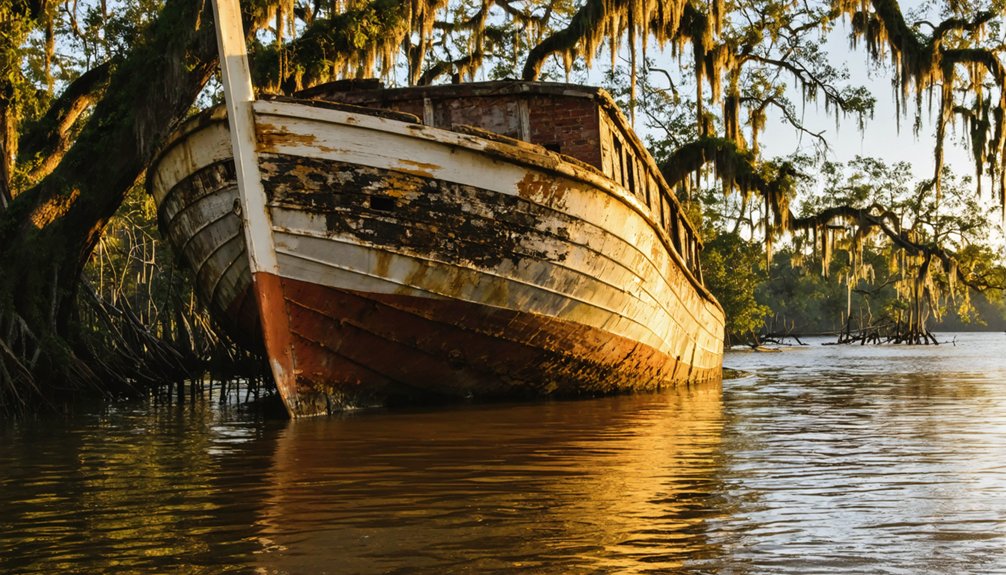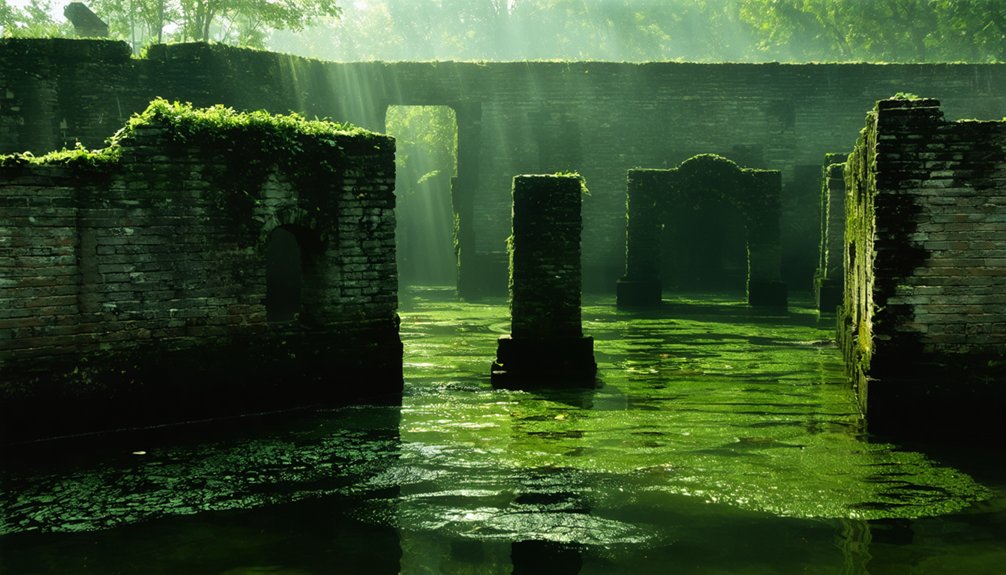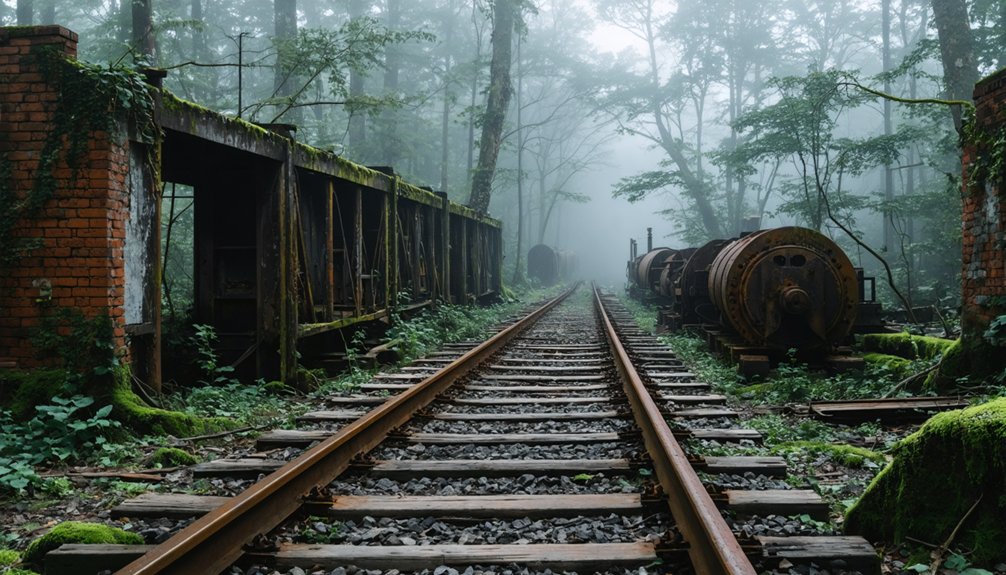You’ll find Petersburg’s remains beneath Clarks Hill Lake today, but in 1804, it was Georgia’s third-largest town and a thriving tobacco trading center. Founded in 1786 by Dionysius Oliver, the town flourished at the confluence of the Broad and Savannah rivers, boasting two U.S. Senators and nine bustling stores. Disease, shifting trade routes, and the arrival of steamboats led to its decline. The lake waters now protect a complex archaeological landscape of lost prosperity.
Key Takeaways
- Petersburg, Georgia was once the state’s third-largest town before becoming submerged beneath Clarks Hill Lake in modern times.
- Economic decline began when steamboats and cotton trade shifted to Augusta, causing property values to fall by over 80%.
- The town’s remains are occasionally visible during droughts, with foundations and artifacts accessible through Bobby Brown State Park.
- Health crises from stagnant waters and malaria, combined with isolation from railroads, contributed to Petersburg’s abandonment.
- Founded in 1786 as a prosperous tobacco inspection center, Petersburg flourished briefly before becoming a ghost town by the mid-1800s.
The Birth of a River Town (1786)
Three key factors converged to birth Petersburg, Georgia in 1786: a strategic river location, a determined founder, and the booming tobacco trade.
At the meeting point of the Broad and Savannah rivers, you’ll find the town establishment site where Dionysius Oliver, a Virginia native, recognized an opportunity. He’d received substantial land grants after the Revolutionary War and chose this spot – previously home to British Fort James and ancient Indian mounds – to build his vision.
The location proved perfect for river commerce, serving the growing Broad River Valley region. Where the British once planned a town called Dartmouth before the Revolution derailed their plans, Oliver created a new settlement that attracted pioneers from Virginia and North Carolina. The town’s appeal grew quickly as Oliver divided the land into eighty-six lots for development.
Petersburg soon emerged as a crucial tobacco inspection center, marking the beginning of its rapid ascent. Oliver quickly divided the land into lots and succeeded in rapidly selling them until his death in 1808.
Rise to Commercial Glory
The blossoming tobacco trade quickly transformed Petersburg from a frontier outpost into one of Georgia’s most prosperous commercial centers.
You’d have found merchants from New York and Boston establishing department stores, while tobacco warehouses dotted the riverside landscape. The economic impact rippled through the region as pole boats connected the town to Augusta, creating a crucial trade network.
Petersburg’s bustling waterfront attracted Northern merchants, while tobacco warehouses and pole boats fueled regional commerce and trade connections.
During this commercial boom, you could’ve witnessed merchants acting as financial agents for planters, while speculation drove property values skyward. By 1804, nine stores were operating, serving the growing community and surrounding areas. Much like its Russian namesake Saint Petersburg, the town became a vital commercial gateway.
The town’s strategic location at the confluence of the Broad and Savannah rivers made it a natural hub for shipping tobacco, cotton, and other goods. Petersburg’s commercial glory was evident in its bustling infrastructure of docks, warehouses, and specialized shops that served the growing population.
Life Along the Rivers
Living along Petersburg’s riverbanks meant adapting to the constant ebb and flow of maritime commerce. You’d find yourself at the heart of river commerce where two ferries connected the town to Lisbon, Georgia, and Vienna, South Carolina.
The bustling waterfront would’ve been your gateway to prosperity, with Petersburg boats – specially designed flat-bottom vessels – carrying tobacco and other goods downstream. The arrival of steamboats to Augusta in 1816 shifted trade routes away from Petersburg. The town’s population reached 750 residents by 1800 during its peak prosperity.
Life centered around the rivers’ rhythms. You’d rely on the Broad and Savannah for transportation, trade, and sustenance.
While there’s no direct mention of a fishing culture in historical records, the town’s location at the fork of two major waterways suggests that residents likely depended on the rivers’ bounty.
Unfortunately, the damp location near stagnant waters brought challenges, possibly contributing to health issues like malaria.
A Tale of Two Senators
You might be surprised to learn that during Petersburg’s prime in the early 1800s, two U.S. Senators called this frontier town home at the same time.
This remarkable political representation highlighted Petersburg’s status as Georgia’s third-largest town, behind only Savannah and Augusta.
The senators’ presence, combined with Petersburg’s role as a major tobacco inspection station, cemented the town’s influence in Georgia’s Broad River Valley region.
Political Powerhouse Emerges
During Georgia’s early statehood, Petersburg emerged as an unlikely political powerhouse, producing two concurrent U.S. Senators – William Wyatt Bibb and Charles Tait.
You’ll find no other example in American history where a single town supplied two sitting senators simultaneously.
The Broad River Valley’s political influence stemmed from prominent families like the Bibbs, Taits, Clarks, and Crawfords.
Before 1914, the Georgia General Assembly selected both senators rather than having them chosen through popular vote.
Bibb’s rise was particularly meteoric – he entered the Georgia House at just 21 before ascending to Congress and later the Senate.
When William Crawford vacated his Senate seat in 1813, Bibb stepped in, serving alongside Tait until 1816.
Both men championed early governance issues through the Democratic-Republican Party, with Bibb significantly defending slave states’ interests against Electoral College reform before departing to become Alabama Territory’s governor.
This tradition of political influence continued well into the 20th century, with Walter F. George serving as senator for an impressive 34-year tenure from 1922 to 1957.
Dual Senate Representation
While most early American towns could only dream of having a single U.S. senator, Petersburg’s strategic location at the confluence of two major rivers helped establish its role in Georgia’s dual Senate representation.
You’d find the town’s influence reflected in the complex political dynamics between Georgia’s two Senate seats, which often represented opposing interests – coastal merchants versus inland farmers.
The state legislature’s power to appoint senators meant Petersburg’s elite could directly shape federal representation.
This transition from regional power dynamics continues today, as shown through the Two-Party Georgia Project documenting the state’s evolving political landscape.
This dual senatorial influence was evident from the start, when William Few and James Gunn became Georgia’s first senators in 1789.
Their divergent constituencies – Few representing upland interests and Gunn aligned with coastal powers – showcased how Petersburg’s position bridged Georgia’s competing political factions.
Today, the 40 days legislative session length ensures debates between senators remain focused and efficient.
The Petersburg Boat Legacy

The Petersburg boat stands as one of the most innovative watercraft designs of early American river commerce.
You’ll find these oak-hulled vessels were masterfully engineered at 60-75 feet long with shallow drafts perfect for traversing the treacherous Savannah and Broad Rivers. Their slender width of 5-8 feet allowed crews to maneuver through tight spots while carrying up to 15 tons of cargo.
These vessels revolutionized river transport through unique navigation techniques.
A skilled crew of six to eight men, led by a patroon at the prow, used poles instead of oars to push against the riverbed and banks. This method gave you precise control over the boat’s movement, especially critical when traversing sandbars and narrow channels that would’ve trapped conventional vessels.
Gradual Descent Into Silence
After reaching its peak in the early 1800s, Petersburg’s descent into oblivion began with a catastrophic real estate collapse that saw property values plummet by over 80%.
You’d have witnessed multiple economic factors converge to strangle the once-thriving town: cotton farmers bypassed Petersburg entirely for Augusta’s markets, steamboats couldn’t navigate the rocky shoals, and railroads never came within 75 miles.
Health crises dealt additional blows as stagnant water filled cellars, breeding malaria and possibly yellow fever.
Disease ravaged the struggling town as flooded basements became breeding grounds for deadly mosquito-borne illnesses.
You’d have seen desperate families fleeing west to Alabama and Mississippi, seeking fresh opportunities as Petersburg withered.
By 1830, the town was in clear decay, and by 1854, only three families remained.
The once-bustling river port had become nothing more than a decaying shell, destined to vanish beneath Clarks Hill Lake’s waters.
Beneath the Waters Today

You’ll find Petersburg’s ghost town remnants hidden beneath Clarks Hill Lake, where droughts periodically expose the foundations of buildings, old roads, and other historical artifacts.
When water levels drop, you can explore the exposed ruins from Bobby Brown State Park, where maritime historians and archaeologists documented significant findings during their 1988 investigation.
Modern technology, including drones, now lets you glimpse these underwater ruins even when lake levels remain high, offering a window into this once-thriving tobacco market center.
Drought Reveals Hidden Ruins
Beneath Lake Strom Thurmond‘s modern waters lie the hidden remains of Petersburg, Georgia, which emerge only during severe droughts when reservoir levels drop considerably.
When drought effects lower the lake by up to 15 feet, you’ll find yourself walking where streets and buildings once stood. The 2002 drought revealed foundations, old roads, and artifacts from this once-thriving town.
During these rare exposures, you can explore the historical significance of Petersburg through scattered pottery, glass, and other remnants of 19th-century life. Bobby Brown State Park provides access to these ruins when conditions permit, though such opportunities are fleeting.
The site has become a temporary attraction during low-water periods, drawing visitors enthusiastic to witness this submerged piece of Georgia’s past as it briefly resurfaces.
Archaeological Finds Below Surface
The waters of Lake Strom Thurmond hold more than just Petersburg’s visible ruins – they protect a complex archaeological landscape spanning thousands of years. Beneath the surface, you’ll find a layered history of human settlement, from ancient Native American mounds to the remains of Georgia’s once-thriving tobacco town.
While underwater archaeology has employed side-scan sonar to explore these submerged cultural resources, much of Petersburg’s physical legacy remains undocumented.
The lake’s waters cover not only the town’s foundations but also significant Indian mounds that once dotted the landscape where the Broad and Savannah rivers meet.
Today, cultural preservation efforts focus on understanding this underwater heritage, though specific findings from Petersburg itself are limited. The site represents a unique challenge for archaeologists working to piece together the story of this frontier settlement.
Frequently Asked Questions
What Diseases Were Common in Petersburg Besides Malaria?
You’d have encountered yellow fever outbreaks, waterborne illnesses like typhoid fever, respiratory diseases, smallpox, and malnutrition-related ailments in Petersburg’s damp, stagnant conditions near the river confluence.
How Many Enslaved People Lived and Worked in Petersburg?
You can’t know the exact enslaved population in Petersburg, though the labor conditions there mirrored Georgia’s Black Belt region, where enslaved people formed large concentrations on cotton plantations throughout the area.
What Happened to the Cemetery When the Town Was Submerged?
While some graves were relocated, most of Petersburg’s cemetery remains frozen in time beneath Clarks Hill Lake’s waters since the 1950s, occasionally visible during droughts but largely undisturbed in its underwater preservation.
Were Any Valuable Artifacts Recovered From Underwater Excavations?
You won’t find records of valuable underwater discoveries at this site – there haven’t been any thorough underwater excavations, and historical artifacts spotted during droughts weren’t systematically collected or documented.
Did Any Notable Native American Settlements Exist at Petersburg Before 1786?
You’ll find evidence of Native American tribes at the site through Indian mounds documented by William Bartram in the 1770s, though Cherokee settlements were primarily located in nearby areas of historical significance.
References
- https://www.georgiaencyclopedia.org/articles/history-archaeology/petersburg/
- https://ugapress.manifoldapp.org/read/old-petersburg-and-the-broad-river-valley-of-georgia-their-rise-and-decline/section/ca8b3569-c2f2-4582-9e3d-c4338ca9c742
- https://www.bobbybrownpark.com/uploads/Petersburg.pdf
- https://www.youtube.com/watch?v=MJxI0vdnyAs
- https://en.wikipedia.org/wiki/Petersburg
- https://www.jacksonville.com/story/news/2013/02/09/drought-lowered-reservoir-offers-glimpse-lost-georgia-city/15838734007/
- https://www.thelamarinstitute.org/index.php?option=com_content&view=article&id=58:petersburg&Itemid=57
- https://www.onlyinyourstate.com/state-pride/georgia/underwater-ghost-town-ga
- https://yesterdaysamerica.com/history-submerged-georgias-drowned-towns/
- https://ugapress.manifoldapp.org/read/old-petersburg-and-the-broad-river-valley-of-georgia-their-rise-and-decline/section/962cbdb2-e1c0-48ed-9ef6-dcd9b8771a7a



